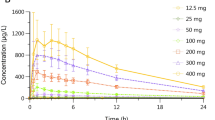Summary
A sensitive HPLC assay has been used to determine the effect of food on plasma endralazine levels in 8 patients with essential hypertension. Subjects were investigated whilst on maintenance therapy with endralazine combined with a fixed antihypertensive baseline treatment for at least 4 weeks, samples being collected after the usual oral morning dose of endralazine (5 mg and 10 mg), on two occasions at least 7 days apart. Endralazine was administered with the concomitant therapy in randomised order once 90 min before and once immediately after a standard breakfast. Acetylator status did not affect its pharmacokinetics in the postprandial study after a 5 mg dose, the peak endralazine concentration averaged 57.5% lower and the AUC had fallen significantly by 49.9%, whereas after 10 mg the postprandial peak level and the AUC were 82.9% and 64.7%, lower. In the 5 mg study the mean arterial blood pressure was decreased by 30 mm Hg in the fasting subjects and by 21 mm Hg in the post-prandial group. For the 10 mg dose the corresponding values were 35 and 24 mm Hg. The blood pressure lowering effect was only weakly correlated with the food — related reduction in the plasma endralazine levels. The results suggest that endralazine has a similar kinetic interaction with food as that found for hydralazine.
Similar content being viewed by others
References
Beermann B, Groschinsky-Grind M (1978) Gastrointestinal absorption of hydrochlorothiazide enhanced by concomitant intake of food. Eur J Clin Pharmacol 13: 125–128
Elliott HL, McLean K, Sumner DJ, Donnelly RJ, Reid JL (1982) Clinical evaluation of endralazine (BQ 22708), a new vasodilator, in essential hypertension. Clin Exp Hypertens [A] 4 [8]: 1409–1418
Fagan TC, Conrad KA, Mar JH, Nelson L (1986) Effects of meals on hemodynamics: Implications for antihypertensive drug studies. Clin Pharmacol Ther 39: 255–260
Holmes DG, Bogers WAJL, Wideroe TE, Huunan-Seppala A, Wideroe B (1983) Endralazine, a new peripheral vasodilator: absence of effect of acetylator status on antihypertensive effect. Results of a multicentre clinical study. Lancet 1: 670–671
Kelly MR, Cutler RE, Forrey AW, Kimpel BM (1974) Pharmacokinetics of orally administered furosemide. Clin Pharmacol Ther 15: 178–186
Kindler J, Glöckner WM, Sieberth HG, Konrads A, Meurer KA, Schulz V, Vaith P (1981) Behandlung der therapieresistenten Hypertonie. Antihypertensive Wirksamkeit von Endralazin im Vergleich mit Minoxidil. Dtsch Med Wochenschr 106: 1176–1181
Kirch W, Axthelm T (1982) Endralazine, a new peripheral vasodilator — a randomized cross-over trial against dihydralazine. J Cardiovasc Pharmacol 4: 562–566
Lehmann HU, Witt E, Hochrein H (1977) Hämodynamische Untersuchungen über ein neues Antihypertensivum (Pyridopyridazin-Derivat) bei der Behandlung der hypertonen Krise und des therapieresistenten Hypertonus. Erste Befunde beim Menschen. Z Kardiol 66: 203–209
Melander A, Danielson K, Schersten B, Wahlin E (1977) Enhancement of the bioavailability of propranolol and metoprolol by food. Clin Pharmacol Ther 22: 108–112
Melander A, Stenberg P, Liedholm H, Schersten B, Wåhlin-Boll E (1979) Food-induced reduction in bioavailability of atenolol. Eur J Clin Pharmacol 16: 327–330
Meredith PA, Elliott HL, McSharry DR, Kelman AW, Reid JL (1983) The pharmacokinetics of endralazine in essential hypertensives and in normotensive subjects. Br J Clin Pharmacol 16: 27–32
Öhman KP, Kagedal B, Larsson R, Karlberg BE (1985) Pharmacokinetics of captopril and its effects on blood pressure during acute and chronic administration and in relation to food intake. J Cardiovasc Pharmacol 7: 20–24
Reece PA, Cozamanis I, Zacest R (1981): Sensitive high-performance liquid chromatographic assay for endralazine and two of its metabolites in human plasma. J Chromatogr 225: 151–160
Reece PA, Cozamanis I, Zacest R (1981) Specific assay and initial pharmacokinetics of a new vasodilator antihypertensive, endralazine. Clin Exp Pharmacol Physiol 8: 602
Reece PA, Cozamanis I, Zacest R (1982) Influence of acetylator phenotype on the pharmacokinetics of a new vasodilator antihypertensive, endralazine. Eur J Clin Pharmacol 23: 523–527
Salzmann R, Bürki H, Chu D, Clark B, Marbach P, Markstein R, Reinert H, Siegl H, Waite R (1979) Pharmakologische Wirkungen des Antihypertensivums 6-Benzoyl-3-hydrazino-5, 6, 7, 8-tetrahydropyrido (4, 3-c) pyridazin (BQ 22-708, Endralazin). Arzneimittelforsch/Drug Res 29 [II]: 1843–1853
Schröder H (1972) Simplified method for determining acetylator phenotype. Brit Med J 3: 506–507
Sheiner LB (1983) A program for the extended least squares fit to individual pharmacokinetic data. Technical report of the Division of Clinical Pharmacology, University of California, San Francisco, CA
Shepherd AMM, Lin M-S, Ludden TM, McNay JL Jr (1979) Relationships between plasma hydralazine (H) concentrations and hypotensive response in patients. Clin Res 27: 738A
Shepherd AMM, Ludden TM, McNay JL, Lin M-S (1980) Hydralazine kinetics after single and repeated oral doses. Clin Pharmacol Ther 28: 804–811
Shepherd AMM, MaNay JL Jr, Ludden TM, Lin M-S, Musgrave GE (1981) Plasma concentration and acetylator phenotype determine response to oral hydralazine. Hypertension 3: 580–585
Shepherd AMM, Irvine NA, Ludden TM (1984) Effect of food on blood hydralazine levels and response in hypertension. Clin Pharmacol Ther 36: 14–18
Wu R, Spence JD, Carruthers SG (1986) Evaluation of once daily endralazine in hypertension. Eur J Clin Pharmacol 30: 553–557
Author information
Authors and Affiliations
Rights and permissions
About this article
Cite this article
Kindler, J., Rüegg, P.C., Neuray, M. et al. Effect of food intake on plasma levels and antihypertensive response during maintenance therapy with endralazine. Eur J Clin Pharmacol 32, 367–372 (1987). https://doi.org/10.1007/BF00543971
Received:
Accepted:
Issue Date:
DOI: https://doi.org/10.1007/BF00543971




